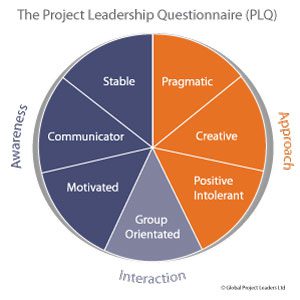 In the first part of this two-part series, I looked at the diverse nature of ‘a project’ across different organisations and as a consequence, project management within those organisations. This post seeks to define the key elements of ‘project management’ and then understand how the concept of professionalism can be applied to the practice.
In the first part of this two-part series, I looked at the diverse nature of ‘a project’ across different organisations and as a consequence, project management within those organisations. This post seeks to define the key elements of ‘project management’ and then understand how the concept of professionalism can be applied to the practice.
The consistent element identified in the last posts that differentiates project management from general management is the temporary and relatively self-contained nature of the project team assigned to undertake the work of the ‘project’. The focus of project management is building a temporary organisation, delivering the project objective and then closing the temporary organisation as efficiently as possible; whereas the focus of general management is the sustainment and improvement of a relatively stable organisation. This core trait of project management is supported by a range of ‘special’ tools, techniques and methodologies designed to assist in the process; these are described in a range of publications not least of which being the PMBOK® Guide.
Therefore, having identified a key difference between project management and general management, it follows ‘project management’ is capable of being seen as a distinct profession.
Understanding the concept of a ‘profession’.
The term ‘profession’ has a number of distinct attributes that have changed over time.
The starting point for being a ‘professional’ is the fact you are paid for your work. Professional football players are paid, amateurs are not (although in many sports, ‘amateurs’ are as skilled as the ‘professionals’).
The next element of ‘professional’ relates to skill and pride in the quality of the work being produced. Many tradespeople consider themselves ‘professional’ bricklayers, plasters, artists, etc., because as well as receiving payment for their work, they are proud of the quality of the work they accomplish.
The traditional concept of a ‘Profession’ (capital ‘P’) builds onto these fundamental attributes by introducing concepts such as ‘public good’. The ‘Professions’ evolved from a need to regulate the delivery of skilled services to the community, the service generally performed by educated gentlemen.
Traditional skills and trades such as stone masons and wool merchants had been represented by The Guilds since the middle ages. This relatively new concept of a university educate gentleman undertaking a skilled role such as accountancy, engineering or surgery needed a new framework (18th-century class structures made joining ‘guilds’ untenable); and the concept of a ‘Professional Institution’, made up of its ‘Professional Members’ emerged.
These Institutions were created by their members to act as regulatory bodies for the Profession they represented that established formal qualifications based upon education and examination, with powers to admit and discipline members, and some degree of monopoly rights in the wider community. Early modern tradition recognised four professions: divinity, medicine, law and engineering. This starting point expanded through the 19th and 20th Centuries to encompass a range of other Professions and the expansion is continuing.
The characteristics of a Profession
Traditionally, a Profession:
- Is an occupationally related social institution concerned with an identified area of knowledge, established and maintained as a means of providing essential services to its individual members and the society in which it operates.
- Renders a specialized service based upon advanced, specialised, knowledge and skill. The profession collectively, and individually, possess a body of knowledge and a repertoire of behaviours and skills (professional culture) needed to practice the profession and make decisions in the service of the client.
- Is organized into one or more professional associations which, within broad limits of social accountability, are granted autonomy in control of the actual work of the profession and the conditions that surround it (admissions, educational standards, examination and licensing, career paths, ethical and performance standards, professional discipline).
- Enjoys a common heritage of knowledge, skill, and status to the cumulative store of which professional members are bound to contribute through their individual and collective efforts.
- Is bound by a distinctive ethical code in its relationships with clients, colleagues, and the public.
- Is charged with a substantial degree of public obligation by virtue of its possession of specialised knowledge.
- Performs its services to a substantial degree in the general public interest, receiving its compensation through limited fees rather than through direct profit from the improvement in goods, services, or knowledge, which it accomplishes.
This framework was supported by governments which used membership of ‘Professional Institutions’ as a convenient way to regulate the provision of services to the general public. For example, the concept of being a ‘doctor’ evolved from the medieval concept of someone with some practical knowledge and skills (possibly acquired by working as an apprentice or assistant) into the modern form where in many parts of the world, to be licenced, a Doctor has to be a member of the relevant professional association.
For traditional ‘Professions’ this tidy arrangement between the individual, the Professional Institution and the government worked very effectively in many parts of the world through to the 1950s and 60s. However, in the last 50 years or so, the traditional framework has started to break down and new concepts are emerging. Governments are increasingly moving to directly regulate the provision of ‘professional services’ to the public, with the professional associations focusing on education, skills development and the encouragement of ‘good practice’. There seems to be three distinct types of professional association:
- Those that qualify and licence members to practice the Profession – sometimes with the support of government regulations.
- Those that qualify members but where the government separately licences the member to practice.
- Those that qualify members but there is no regulatory constraints on practice – membership is a ‘competitive advantage.
The concept of ‘professional institutions’ such as PMI and IPMA fit into this last paradigm. The ‘Associations’ are focused on developing the knowledge and capability of the profession but anyone can practice.
This creates an interesting anomaly! Traditionally ‘Professions’ emerged from a group of professional practitioners creating an association to protect and advance their specialist skills and knowledge, restrict entry to the Profession and frequently (with the support of governments) prevent non-professionals from practicing in the field.
In contrast, project management would appear to have evolved to the stage where there are Professional Institutions, fulfilling all of the traditional roles of knowledge development, standard and qualification setting. But to a large extent, it is the Associations that are driving the development of the profession and are actively seeking members. Many individuals are ‘Professional Project Managers’ by choice, the lack of regulation allows anyone to practice.
This suggests the concept of ‘Professionalism’ is changing and the consequences of the evolution of precisely what it means to be ‘A Profession’ is far from certain. The only thing that is clear at the present time is that the old style ‘gentlemen’s clubs’ with power to restricted access to the Profession they represented are losing that power. A speculative assessment of the role and function of the Professions in the 21st Century suggests:
- Governments will increasingly take control of the ‘right to practice’ but only in the areas where public safety is an issue.
- Professional Associations / Institutions will remain custodians of the specialist knowledge, skills and practice underpinning the Profession they represent, set benchmarks for qualifications and provide a link between practitioners and academia.
- Individuals will increasingly separate qualifications and certifications from membership of associations. The qualification will be an important benchmark in a person’s career development, whereas membership of an Association will become optional.
- Associations may find restricting membership to fully qualified practitioners unnecessary or untenable.
So, to answer the question posed at the start of these articles ‘Is project management a Profession?’ if your benchmark is the practices of the 19th and 20th centuries, definitely not – the ‘Professional Associations’ do not control the right to practice as a project manager. However, in the paradigm of the 21st century, we are well on the way to being a ‘modern profession’ based on Professional Associations. And while the ‘right to practice’ project management is never likely to regulated (we don’t threaten public safety in the way doctors and engineers can); the desire of employers to engage Professional Project Managers (ie, capable, qualified and ethical people) is already becoming apparent.
The challenge for the Associations over the next few years will be developing the elements beyond certifications needed to support Professional Project Managers, and to create ways to make this distinction attractive to members and recognisable to employers – simple certifications are unlikely to be enough.



